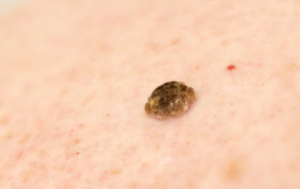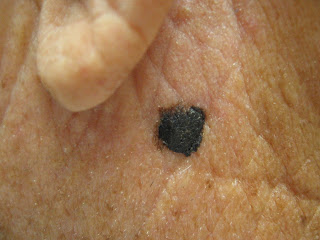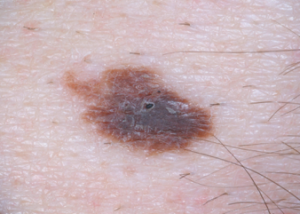
If you’ve discovered a new mole and you’re 60-plus, don’t wait to get this checked out by a dermatologist.
If you’re over age 60 you may be noticing new spots arising on your skin on a frequent basis (age spots), but suppose you notice something that appears to be a new mole — as in birthmark or like other moles you’ve had on your body since the day you could remember.
It’s not normal for a person over age 60 to develop a new mole.
A mole is not the same as a sun spot or age spot.
What appears to be a new mole may not be an actual mole (known as a nevus to dermatologists—pronounced “nee-vus”).
That new lesion may be a benign skin barnacle, known as a seborrheic keratosis. Or, it could be melanoma.

Seborrheic keratosis. Shutterstock/
Only a biopsy can rule out melanoma. A “new mole” in someone over age 60 should be biopsied for melanoma.
Such a melanoma can progress quickly, as in the case below.

Courtesy of Dr. Gary Goldenberg
“The lesion appeared three months ago and grew rather rapidly,” says Gary Goldenberg, MD, of Goldenberg Dermatology, and assistant professor of dermatology and pathology at Mount Sinai School of Medicine.
Dr. Goldberg explains, “It was slightly painful and itchy. A biopsy was performed and showed a nodular melanoma.
“The patient underwent a surgical excision. Patient is a 68 year old white male who came in with a ‘new mole.’”

Dr. Goldenberg of Goldenberg Dermatology provides comprehensive care in medical and cosmetic dermatology, including melanoma and other skin cancer, moles, psoriasis, eczema and acne. He is the medical director of the Dermatology Faculty Practice, NY.
 Lorra Garrick has been covering medical, fitness and cybersecurity topics for many years, having written thousands of articles for print magazines and websites, including as a ghostwriter. She’s also a former ACE-certified personal trainer.
Lorra Garrick has been covering medical, fitness and cybersecurity topics for many years, having written thousands of articles for print magazines and websites, including as a ghostwriter. She’s also a former ACE-certified personal trainer.
.









































